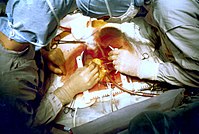
Photo from wikipedia
AIMS Operability of type A acute aortic dissections (TAAAD) is currently based on non-standardized decision-making process, and it lacks a disease-specific risk evaluation model that can predict mortality. We investigated… Click to show full abstract
AIMS Operability of type A acute aortic dissections (TAAAD) is currently based on non-standardized decision-making process, and it lacks a disease-specific risk evaluation model that can predict mortality. We investigated patient, intraoperative data, surgeon, and centre-related variables for patients who underwent TAAAD in the UK. METHODS AND RESULTS We identified 4203 patients undergoing TAAAD surgery in the UK (2009-18), who were enrolled into the UK National Adult Cardiac Surgical Audit dataset. The primary outcome was operative mortality. A multivariable logistic regression analysis was performed with fast backward elimination of variables and the bootstrap-based optimism-correction was adopted to assess model performance. Variation related to hospital or surgeon effects were quantified by a generalized mixed linear model and risk-adjusted funnel plots by displaying the individual standardized mortality ratio against expected deaths. Final variables retained in the model were: age [odds ratio (OR) 1.02, 95% confidence interval (CI) 1.02-1.03; P < 0.001]; malperfusion (OR 1.79, 95% CI 1.51-2.12; P < 0.001); left ventricular ejection fraction (moderate: OR 1.40, 95% CI 1.14-1.71; P = 0.001; poor: OR 2.83, 95% CI 1.90-4.21; P < 0.001); previous cardiac surgery (OR 2.29, 95% CI 1.71-3.07; P < 0.001); preoperative mechanical ventilation (OR 2.76, 95% CI 2.00-3.80; P < 0.001); preoperative resuscitation (OR 3.36, 95% CI 1.14-9.87; P = 0.028); and concomitant coronary artery bypass grafting (OR 2.29, 95% CI 1.86-2.83; P < 0.001). We found a significant inverse relationship between surgeons but not centre annual volume with outcomes. CONCLUSIONS Patient characteristics, intraoperative factors, cardiac centre, and high-volume surgeons are strong determinants of outcomes following TAAAD surgery. These findings may help refining clinical decision-making, supporting patient counselling and be used by policy makers for quality assurance and service provision improvement.
Journal Title: European heart journal
Year Published: 2021
Link to full text (if available)
Share on Social Media: Sign Up to like & get
recommendations!